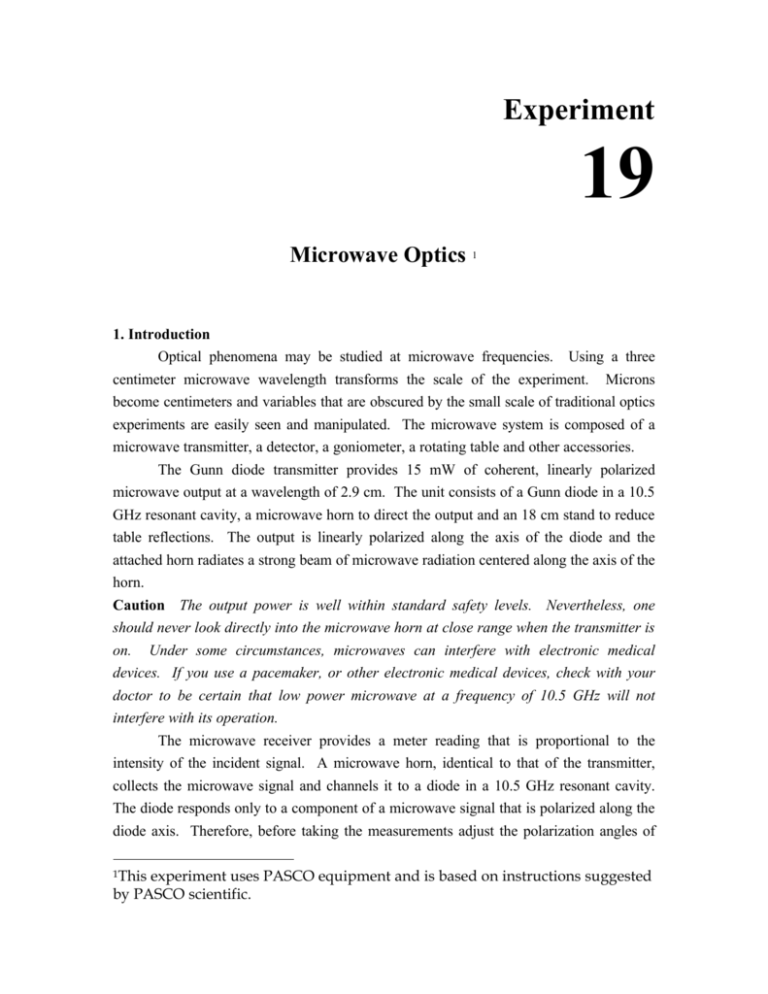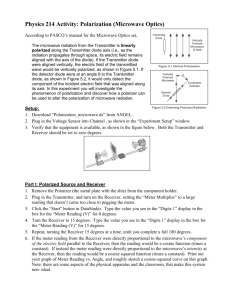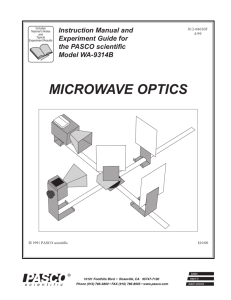Lab 19
advertisement

Experiment 19 Microwave Optics 1 1. Introduction Optical phenomena may be studied at microwave frequencies. Using a three centimeter microwave wavelength transforms the scale of the experiment. Microns become centimeters and variables that are obscured by the small scale of traditional optics experiments are easily seen and manipulated. The microwave system is composed of a microwave transmitter, a detector, a goniometer, a rotating table and other accessories. The Gunn diode transmitter provides 15 mW of coherent, linearly polarized microwave output at a wavelength of 2.9 cm. The unit consists of a Gunn diode in a 10.5 GHz resonant cavity, a microwave horn to direct the output and an 18 cm stand to reduce table reflections. The output is linearly polarized along the axis of the diode and the attached horn radiates a strong beam of microwave radiation centered along the axis of the horn. Caution The output power is well within standard safety levels. Nevertheless, one should never look directly into the microwave horn at close range when the transmitter is on. Under some circumstances, microwaves can interfere with electronic medical devices. If you use a pacemaker, or other electronic medical devices, check with your doctor to be certain that low power microwave at a frequency of 10.5 GHz will not interfere with its operation. The microwave receiver provides a meter reading that is proportional to the intensity of the incident signal. A microwave horn, identical to that of the transmitter, collects the microwave signal and channels it to a diode in a 10.5 GHz resonant cavity. The diode responds only to a component of a microwave signal that is polarized along the diode axis. Therefore, before taking the measurements adjust the polarization angles of 1This experiment uses PASCO equipment and is based on instructions suggested by PASCO scientific. both the transmitter and the receiver to the same orientation. The intensity selection settings (30X, 10X, 3X and 1X) are the values by which you must multiple the meter reading to normalize your measurements. That is, 30X means that you must multiple the meter reading by 30 to get the same value you would get if you measured the same signal with the intensity selection set to 1X. Of course, this is true only if you do not change the position of the VARIABLE SENSITIVITY knob between measurements. In this experiment you will study reflection and polarization of microwaves, and measure the wavelength by generating a standing wave. 2.1. Reflection Arrange the equipment as shown in Fig. 1, with the transmitter on the fixed end of the goniometer. Be sure that the transmitter and receiver are adjusted to the same polarity. Turn the receiver intensity selection switch to 30X. The angle between the incident wave from the transmitter and the line normal to the reflector is the angle of incidence (see Fig. 1). Adjust the rotating holder so that the angle of incidence equals 45 degrees. Without moving the transmitter or the reflector rotate the movable arm of the goniometer until the meter reading is a maximum. The angle between the axis of the receiver and a line normal to the plane of the reflector is called the angle of reflection. Fig. 1. Angles of incidence and reflection. Measure and record the angle of reflection for each of the angles of incidence shown in Table 1. (At some angles the receiver will detect not only the reflected wave but also the wave coming directly from the transmitter giving misleading results. Determine the angles for which this is true.) Table 1 Angle of incidence Angle of reflection 20o 30o 40o 50o 60o 70o 80o 90o Replace the metal reflector with the partial reflector made of plastic and repeat the measurements. 1. 2. 3. 2.2. Report In the report answer the following questions: What relationship holds between the angle of incidence and the angle of reflection? Does this relationship hold for all angles of incidence? In determining the angle of reflection, you measured the angle at which a maximum meter reading was found. Can you explain why some of the wave was reflected into different angles? How does it affect your answer to question 1? How does reflection affect the intensity of microwave? Is all the energy of the wave that strikes the reflector reflected? What has happened to the missing energy? Polarization The microwave radiation from the transmitter is linearly polarized along the axis of the diode; that is, as the radiation propagates through space, its electric vector remains aligned with the axis of the diode. If the transmitter diode is aligned vertically the microwave radiation is also polarized vertically, as shown in Fig. 2. If the detector diode were at an angle θ to the transmitter diode, as shown in Fig. 3, it would only detect the component of the incident electric field that was aligned along that axis. In this part of the experiment you will investigate how a polarizer can be used to alter the polarization of microwave radiation. Fig. 2. Vertical polarization Fig. 3. Detecting polarized radiation Place the detector opposite to the transmitter. Loosen the hand screw on the back of the receiver and rotate the receiver in increments of 10 degrees until you reach 180 degrees. At each position record the meter reading. Table 2 Angle of receiver 0o 20o 40o 60o 80o 100o 120o 140o 160o 180o Meter reading Angle of receiver 10o 30o 50o 70o 90o 110o 130o Meter reading 150o 170o Setup the equipment as shown in Fig. 4, and reset the angle of rotation of the receiver for vertical polarization. With the slits of the polarizer aligned horizontally, find the orientation of the receiver for which the meter will show the minimum deflection. Repeat this measurement with the slits aligned at about 22.5, 45, 67.5 and 90 degrees with respect to the horizontal. Fig. 4. Polarization measurements. Report Graph the data from Table 2. If the meter reading, M, were proportional to the component of the electric field, E, along its axis, then the meter reading would be given by the relationship M =Mo cos θ. Μο is the maximum reading of the meter. If the intensity of a wave is proportional to the square of the electric field (e.g.; I = kE2), then the meter reading would be given by M =Mo cos2θ. Plot both functions (cosθ and cos2θ) on the same graph as your experimental data and discuss the relationship between the meter reading and the polarization and magnitude of the incident microwave. Explain how the polarizer affects the incident microwave. Standing waves - measuring λ When two waves meet in space, they superinpose, so that the total electric field at any point is the sum of the electric fields of two waves at that point. If the two waves have the same frequency, and are traveling in the opposite directions, a standing wave is formed. The points where the fields of two waves cancel are called nodes; points where the oscillations are at maximum are called antinodes. The distance between two adjacent nodes (or antinodes) in the standing wave is exactly 1/2 λ, where λ is the wavelength of the radiation. In this part of the experiment you will measure the wavelength of microwaves generated by the transmitter. Set up the transmitter and the receiver on the goniometer as close together as possible and adjust the receiver controls to get a full scale meter reading. Slowly move the receiver away from the transmitter. You should notice that beam intensity decreases with the increasing distance, but you should also be able to notice fluctuations in the meter reading. These fluctuations are due to radiation reflected from the receiver. The 2.3. microwave horns are not perfect collectors of microwave radiation. Instead, they act as partial reflectors, so that the radiation from the transmitter is reflected back and forth between the two horns, diminishing in amplitude at each pass. If the distance between the transmitter and receiver diodes is equal to nλ/2, where n is an integer, then all the multiply-reflected waves entering the receiving horn will be in phase with the primary emitted wave. When this occurs, the meter reading will be a maximum. Therefore, the distance between two adjacent positions where a maximum will be seen is λ/2. Slide the receiver one or two centimeter along the goniometer arm to obtain a maximum meter reading. Record the initial position of the receiver on the metric scale of the goniometer. While watching the meter, slide the receiver away from the transmitter, until the receiver has passed through at least 10 positions at which you see a minimum meter reading, and return to a position where the reading is a maximum. Record the new position of the receiver. Use the data to calculate the wavelength of the microwave radiation. Repeat the procedure and recalculate the wavelength. Use the formula v = λν to calculate the velocity of microwave propagation in air. microwave radiation used in the experiment; ν is 10.5 GHz. (1) ν is the frequency of the Report Estimate the error. Compare calculated speed of light with the textbook value and discuss possible sources of error.







